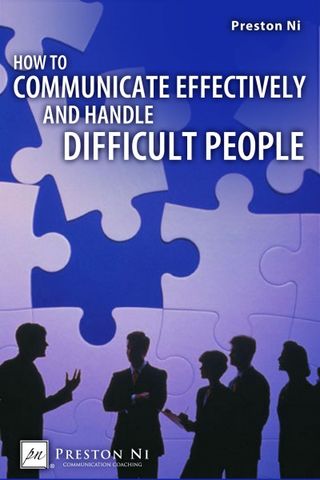Humor
How to Handle Difficult People – A Tao Perspective
How to deal with difficult people.
Posted April 6, 2014
“To subdue the enemy without fighting is the highest skill.”
— Gichin Funakoshi, father of modern Karate
“The Chinese call it Chi; the Japanese, Ki; the Indians Prana – it is the life force, and it is incredibly powerful…it can’t be explained adequately except to those who have already experienced it, but it’s one of the very few willable miracles.”
— Kareem Abdul-Jabbar, 19-time NBA All-Star, describing how he accesses his inner strength
Tao, the ancient Chinese concept of “the way,” can be interpreted as harnessing and flowing with your life force (“Chi”) so you experience composure and equanimity within, while projecting supple and effective strength without.
Below are five ways you can apply Taoist principles to the handling of difficult people, with references from my books How to Communicate Effectively and Handle Difficult People and How to Successfully Handle Passive-Aggressive People. Keep in mind that these are general rules of thumb, and not all of the tips may apply to your particular situation. Simply utilize what works and leave the rest.

1. Empty Your Cup – Release Negative Emotions and Maintain Composure
"Emptiness the starting point…drop all your preconceived and fixed ideas and be neutral. Do you know why this cup is useful? Because it is empty.”
— Bruce Lee, philosopher and founder of Jeet Kune Do
It's easy to allow a difficult person to upset us and ruin our day. You may feel angry, distressed, and lose your balance within. The first rule in the face of an unreasonable person is to maintain your composure. The less reactive you are, the more you can use your better judgment to handle the challenge.
When you feel angry or upset with someone, before you say something you might later regret, take a deep breath and count slowly to ten. In most circumstances, by the time you reach ten, you would have figured out a better way of communicating the issue, so that you can reduce, instead of escalate the problem. If you're still upset after counting to ten, take a time out if possible, and revisit the issue after you calm down. By maintaining self-control, you harness more power to manage the situation.
"Breathing...corresponds to taking charge of one's own life."
― Luce Irigaray, philosopher
2. See Both Sides – Shift from Being Reactive to Proactive
“Don't have preconceived notions about anything. Don't be confined by anything, Achieve true freedom.”
— Jeet Kune Do creed
You may feel wronged or victimized by the actions of a difficult individual. While such sentiments are often understandable and justified, to focus primarily on "what he/she is doing to me" is to miss the opportunity of a broader, more empowering perspective. By looking at the situation from a wider lens, you can begin to restore your inner balance, and set upon handing the issue from a proactive, rather than reactive stance.
When you feel offended by someone’s words or deeds, come up with multiple ways of viewing the situation before reacting. For example, I may be tempted to think that my friend is ignoring my calls, or I can consider the possibility that he’s been very busy. When we avoid personalizing other people's behaviors, we can perceive their expressions more objectively. People do what they do because of them more than because of us. Widening our perspective on the situation can reduce the possibility of misunderstanding.
Another way to reduce personalization is to try to put ourselves in the difficult individual’s shoes, even for just a moment. For example, consider the person you’re dealing with, and complete the sentence: “It must not be easy...”
“My child is being so resistant. It must not be easy to deal with his school and social pressures…”
“My manager is really demanding. It must not be easy to have such high expectations placed on her performance by management…”
“My partner is so emotionally distant. It must not be easy to come from a family where people don’t express affection…”
To be sure, empathetic statements do not excuse unacceptable behavior. The point is to restore your inner equanimity, and remind yourself that people do what they do because of their own issues. As long as we’re being reasonable and considerate, difficult behaviors from others say a lot more about them than they do about us. By reducing personalization, we can be less reactive and concentrate our energy on problem-solving.
3. Achieve Balance – Be Soft on the Person and Firm on the Issue
“Be soft, yet not yielding. Be firm, yet not hard.”
— Bruce Lee
In every communication situation, there are two elements present: The relationship you have with this person, and the issue you are discussing. An effective communicator knows how to separate the person from the issue, and be soft on the person and firm on the issue. For example:
“I want to talk about what’s on your mind, but I can’t do it when you’re yelling. Let’s either sit down and talk more calmly, or take a time out and come back this afternoon.”
“I appreciate you putting a lot of time into this project. At the same time, I see that three of the ten requirements are still incomplete. Let’s talk about how to finish the job on schedule.”
“I really want you to come with me. Unfortunately, if you’re going to be late like last time, I’ll have to leave without you.”
When you’re soft on the person, people are more open to what you have to say. When you’re firm on the issue, you show yourself as a strong problem solver.

4. Be Like Water – Use Appropriate Humor
“Nothing in the world
Is as soft and yielding as water.
Yet for dissolving the hard and inflexible,
Nothing can surpass it.”
— Lao Tzu, founder of Taoism
Humor is a powerful communication tool. Years ago I knew a co-worker who was quite stuck up. One day a colleague of mine said “Hello, how are you?” to him. When the egotistical co-worker ignored her greeting completely, my colleague didn’t feel offended. Instead, she smiled good-naturedly and quipped: “That good, huh?” This broke the ice and the two of them started a friendly conversation. Brilliant.
When appropriately used, humor can shine light on the truth, disarm difficult behavior, and show that you have superior composure.
5. Apply Your Strength Like Bamboo – Set Consequence
“There are times when it seems as if one must intervene powerfully...The wise leader does this only when all else fails.”
— The Tao of Leadership
“Bend slightly and then spring up stronger than before.”
— Bruce Lee
The ability to identify and assert consequence(s) is one of the most important skills we can use to "stand down" a difficult person. Effectively articulated, consequence gives pause to the challenging individual, and compels her or him to shift from obstruction to cooperation. In How to Communicate Effectively and Handle Difficult People, consequence is presented as seven different types of power you can utilize to affect positive change.
In conclusion, to know how to handle difficult people is to truly practice the art of influence. As you utilize these skills, you may experience less grief, greater confidence, better relationships, and higher communication prowess. You are on your way to Tao mastery!

For more in-depth tools on how to effectively handle difficult individuals, see my books (click on titles): "How to Communicate Effectively and Handle Difficult People" and "How to Successfully Handle Passive-Aggressive People".
Follow me on Twitter, Facebook, and LinkedIn!
© 2014 by Preston C. Ni. All rights reserved worldwide. Copyright violation may subject the violator to legal prosecution.




